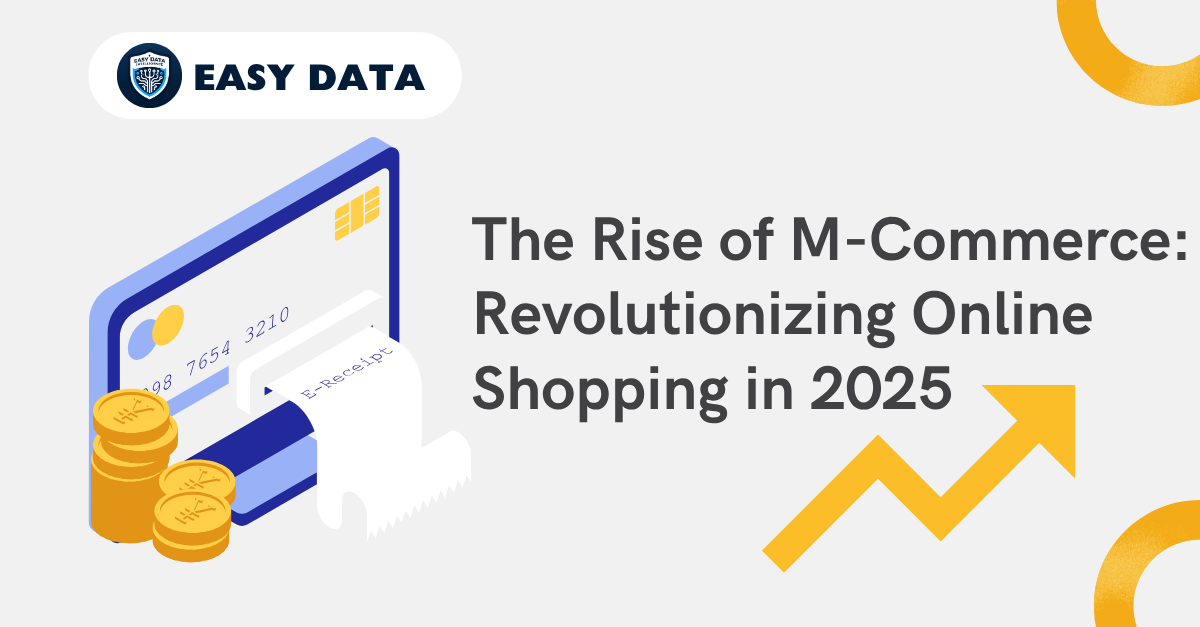Mobile commerce, or mcommerce, is transforming the way consumers interact with businesses, reshaping the retail landscape with unprecedented speed and scale. As smartphones become indispensable tools for billions worldwide, m commerce is no longer just a trend but a cornerstone of modern retail. By 2025, mcommerce growth is projected to account for a significant portion of global e-commerce sales, driven by technological advancements, shifting consumer behaviors, and innovative m commerce strategies. This article explores the advantages of m commerce, the future of m commerce, key m commerce trends, and how businesses can leverage m commerce platforms and m commerce services to stay competitive.
What is M-Commerce?
M commerce mobile commerce refers to the buying and selling of goods and services through wireless handheld devices such as smartphones and tablets. Unlike traditional e-commerce, which primarily relies on desktops or laptops, mcommerce focuses on mobile-optimized experiences, offering streamlined interfaces, mobile payments, push notifications, and location-based services. It encompasses a wide range of activities, including mobile shopping, mobile banking, and mobile payments, making it a versatile and rapidly growing subset of e-commerce.

The convenience and portability of mobile devices have fueled the growth of m commerce, enabling consumers to shop anytime, anywhere, with just a few taps. In 2024, global mcommerce sales reached an estimated $2.52 trillion, and projections suggest this figure will climb to over $3.2 trillion by 2026, accounting for more than 44% of total e-commerce sales in key markets like the US and UK.
The Advantages of M-Commerce
The rapid adoption of m commerce is driven by its numerous benefits for both consumers and businesses. Here are the key advantages of m commerce:

1. Convenience and Accessibility
One of the most significant advantages of m commerce is the ability to shop from anywhere at any time. Whether commuting, waiting in line, or relaxing at home, consumers can browse products, compare prices, and complete purchases with ease. This convenience has made m commerce mobile commerce the preferred shopping method for 79% of smartphone users who have made an online purchase via their mobile device in the past six months.
2. Personalized Shopping Experiences
M commerce platforms leverage advanced data analytics to deliver highly personalized experiences. By analyzing user demographics, browsing history, and purchase behavior, businesses can offer tailored product recommendations, targeted promotions, and dynamic content. For example, 61% of smartphone users prefer brands that provide personalized experiences, making smart personalization a key m commerce strategy for 2025.
3. Faster Transactions
Mobile devices are designed for speed and responsiveness, enabling faster transaction processing compared to desktop-based e-commerce. Features like one-click checkout and mobile wallets (e.g., Apple Pay, Google Pay) streamline the purchase process, reducing friction and boosting conversion rates. In fact, mobile apps convert 157% more than mobile web sessions, highlighting the efficiency of m commerce services.
4. Cost-Effectiveness for Businesses
For businesses, m commerce is often more cost-effective than traditional e-commerce. It requires less investment in infrastructure and can be seamlessly integrated with existing systems. Additionally, m commerce platforms allow businesses to reach a broader audience without the need for physical storefronts, reducing overhead costs.
5. Enhanced Customer Engagement
M commerce services like push notifications and location-based marketing enable businesses to engage customers in real time. For instance, proximity marketing using WiFi and BLE-powered beacons allows retailers to send personalized discounts to shoppers within a specific radius of their physical stores, driving both online and in-store sales.
The Growth of M-Commerce
The growth of m commerce has been nothing short of remarkable. In 2024, mcommerce accounted for 66% of global e-commerce sales, with mobile devices driving 56.2% of all website traffic. This trend is expected to accelerate, with mcommerce growth projected to reach $700 billion in the US alone by 2025, a 100% increase from previous years.
Several factors contribute to this explosive growth:

1. Widespread Smartphone Adoption
With over 7.49 billion smartphone users globally by 2025, mobile devices have become the primary gateway to the digital marketplace. Countries like China, India, and the US lead in smartphone penetration, creating a fertile ground for m commerce mobile commerce.
2. Rise of Mobile Apps
Mobile shopping apps are growing faster than any other app category, with usage increasing by 54% year-on-year. Consumers prefer apps over mobile websites due to their superior user experience, speed, and features like offline mode and push notifications. In 2024, 70% of mcommerce purchases were made via mobile apps rather than mobile browsers.
3. Social Commerce Integration
Social media platforms like Instagram, TikTok, and Facebook have become powerful m commerce platforms, with global social commerce sales projected to reach $1.2 trillion by 2025. Features like shoppable posts and livestream shopping allow users to discover and purchase products without leaving the app, driving mcommerce growth.
4. Advancements in Mobile Payments
The mobile payments market is expected to grow at a CAGR of 24.5% from 2021 to 2026, with digital wallets like Apple Pay and Google Pay leading the charge. QR code payments are also gaining traction, with an estimated 2.2 billion users worldwide by 2025. These innovations enhance the security and convenience of m commerce services, further fueling adoption.
The Future of M-Commerce
The future of m commerce is bright, with emerging technologies and evolving consumer preferences shaping its trajectory. Here are the key trends and innovations to watch in 2025 and beyond:

1. AI-Driven Personalization
Artificial intelligence (AI) is revolutionizing m commerce by enabling hyper-personalized shopping experiences. AI algorithms analyze vast amounts of data to deliver tailored product recommendations, dynamic pricing, and predictive analytics. By 2025, generative AI is expected to account for 10% of all product data produced, enhancing the personalization capabilities of m commerce platforms.
2. Augmented Reality (AR) Shopping
Augmented reality is transforming the way consumers shop online by allowing them to visualize products in real-world settings. For example, IKEA’s “IKEA Place” app lets users see how furniture would look in their homes, reducing return rates by boosting purchase confidence. In 2025, 92% of Gen Z consumers are expected to use AR tools for e-commerce, making it a critical component of m commerce strategies.
3. Voice Commerce
Voice search and voice-activated shopping are gaining momentum, with voice commerce projected to reach $164 billion by 2025. Consumers are increasingly using digital assistants like Siri, Alexa, and Google Assistant to research products, track orders, and make purchases. Businesses must optimize their m commerce platforms for natural language and question-based queries to capture this growing market.
4. Live Commerce
Live commerce, which blends entertainment with real-time shopping, is redefining m commerce trends. Platforms like TikTok Live and eBay Live enable brands to host interactive product demos and exclusive sales events, driving instant purchases. In the US, livestreaming e-commerce sales are expected to reach $68 billion by 2026, with significant growth in mcommerce markets.
5. Progressive Web Apps (PWAs)
Progressive web apps are emerging as a game-changer for m commerce. PWAs combine the functionality of native apps with the accessibility of web browsers, offering features like offline mode, push notifications, and fast load times. They are cost-effective for businesses and provide a seamless user experience, making them a key m commerce trend for 2025.
6. Blockchain and Cryptocurrency
Blockchain technology is enhancing the security and transparency of m commerce transactions, while cryptocurrencies are gaining traction as a payment option. The cryptocurrency market is expected to reach $1.4 billion in 2024, with blockchain wallets replacing traditional payment methods in many m commerce platforms. This trend is set to future-proof m commerce services as consumer interest in virtual currencies grows.
Building an Effective M-Commerce Strategy
To capitalize on the growth of m commerce, businesses must adopt a robust m commerce strategy. Here are actionable steps to succeed in the mcommerce landscape:

1. Optimize for Mobile-First Design
With 61% of Google searches conducted on mobile devices, a mobile-optimized website or app is non-negotiable. Ensure fast load times, responsive design, and intuitive navigation to reduce bounce rates and improve user experience. Tools like Google PageSpeed Insights can help identify and fix performance issues.
2. Leverage Social Commerce
Integrate m commerce services with social media platforms to reach a wider audience. Use shoppable tags on Instagram, host livestream shopping events on TikTok, or create a seamless checkout experience on Facebook. Consistent branding across all channels is crucial for an omnichannel m commerce strategy.
3. Invest in Personalization
Use AI and data analytics to deliver personalized content based on user behavior, preferences, and location. For example, displaying products viewed on a mobile device when the user logs in via a tablet enhances the shopping experience and boosts conversions.
4. Enhance Payment Options
Offer a variety of payment methods, including mobile wallets, Buy Now, Pay Later (BNPL), and QR code payments. By 2025, BNPL spending is expected to reach $108.43 billion, making it a critical component of m commerce platforms.
5. Prioritize Security
Security remains a top concern for m commerce users, with mobile fraud attempts rising to 61% in 2023. Implement robust security measures like encryption, secure payment gateways, and zero-party data collection to build consumer trust.
6. Adopt Emerging Technologies
Incorporate AR, voice commerce, and PWAs into your m commerce strategy to stay ahead of the curve. These technologies enhance user engagement and provide a competitive edge in the crowded mcommerce market.
Challenges in M-Commerce
Despite its advantages, m commerce faces several challenges that businesses must address:

1. Cart Abandonment
Cart abandonment rates are higher on mobile devices (84%) compared to desktops (72%). Additional costs like shipping and taxes are a significant factor, underscoring the need for transparent pricing and streamlined checkout processes.
2. Security Concerns
Mobile transactions are vulnerable to fraud, with 61% of online fraud attempts in 2023 originating from mobile browsers. Businesses must invest in advanced security protocols to protect customer data and ensure safe transactions.
3. High Development Costs
Building a robust m commerce platform can be costly, especially for small businesses. However, starting with a mobile-optimized website and gradually scaling to a full-fledged app can spread out the investment over time.
Conclusion
Mcommerce is revolutionizing the retail industry, offering unmatched convenience, personalization, and accessibility for consumers while providing businesses with cost-effective and scalable solutions. The growth of m commerce is driven by widespread smartphone adoption, innovative m commerce services, and evolving consumer preferences. As we move into 2025, the future of m commerce will be shaped by technologies like AI, AR, voice commerce, and blockchain, creating new opportunities for businesses to engage customers and drive sales.
To stay competitive, businesses must adopt a mobile-first mindset, leveraging m commerce platforms and m commerce strategies to deliver seamless, personalized shopping experiences. By staying updated on m commerce trends and addressing challenges like cart abandonment and security concerns, retailers can unlock the full potential of m commerce mobile commerce.
For more insights into the evolving e-commerce landscape, check out our article on the Top 10 E-Commerce Trends to Watch in 2025.


Leave a Reply